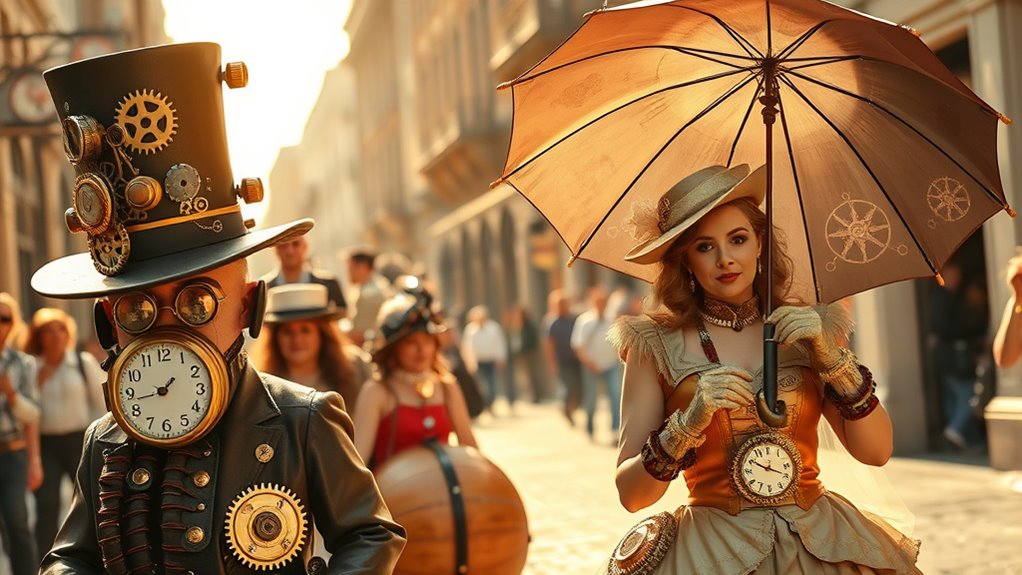Humor and parody are essential in steampunk, adding a playful twist to its intricate worlds. You’ll notice witty satire that critiques Victorian society’s pretensions and class distinctions, often exaggerating manners for comic effect. Parodies of inventors and industrial themes highlight the absurdities of technological obsession and corporate greed. This comedy not only entertains but also prompts reflection on societal norms. If you keep exploring, you’ll discover how these elements shape steampunk’s unique charm and storytelling depth.
Key Takeaways
- Humor and parody add playful, satirical twists to the complex Victorian-inspired steampunk worlds.
- They critique societal norms and technological excesses through exaggerated Victorian manners and class distinctions.
- Parody reimagines inventors and industry, humorously highlighting their flaws and absurdities.
- These elements provide comic relief and make intricate steampunk settings more accessible and engaging.
- Humor and parody serve as tools to reflect on past societal issues and modern technological trends within the genre.

Steampunk, with its blend of Victorian aesthetics and futuristic invention, often embraces humor and parody to add a playful twist to its intricate worlds. This genre doesn’t take itself too seriously, instead using wit and satire to critique and celebrate its complex, steam-powered universe. Victorian satire plays a significant role here, poking fun at the rigid social hierarchies, societal pretensions, and moral hypocrisies of the Victorian era. You’ll find stories and artwork that exaggerate Victorian manners or highlight the absurdity of class distinctions, all wrapped in a whimsical, steampunk veneer. It’s a clever way to pay homage to history while pointing out its flaws, making the genre not just visually intriguing but intellectually engaging as well.
Steampunk humorously lampoons Victorian manners and class distinctions with whimsical, satirical flair.
Industrial satire, on the other hand, focuses on the excesses, dangers, and environmental impact of rapid technological progress. You might encounter stories that lampoon the obsession with invention, depicting mad scientists or overzealous engineers whose creations run amok. This form of humor often underscores the sometimes ridiculous pursuit of progress at any cost, highlighting how industrialization can lead to chaos or unintended consequences. The satire isn’t just for laughs; it’s a critique of unchecked innovation and corporate greed, wrapped in a playful, exaggerated tone that invites you to question the real-world implications of technological obsession. It’s this blend of humor and critique that makes steampunk’s parody elements so compelling—you get entertainment that also sparks reflection.
You’ll notice that humor in steampunk often manifests through parody, whether it’s a humorous take on Victorian customs or a satirical exaggeration of industrial society. Parody allows creators to mimic historical tropes or technological concepts, twisting them into something comically absurd or sharply insightful. For instance, a steampunk story might reimagine a Victorian inventor as a bumbling fool whose inventions malfunction spectacularly, or it might parody the pomp and circumstance of Victorian society through over-the-top costumes and exaggerated manners. These playful imitations serve to entertain while subtly questioning societal norms and technological trends of the past—and, by extension, our own.
Humor and parody in steampunk aren’t just decoration; they’re essential tools that give the genre its unique voice. They make complex worlds accessible and relatable, providing comic relief amid intricate machinery and elaborate costumes. They invite you to laugh at the absurdities of Victorian and industrial life while contemplating their deeper meanings. By blending satire with inventive storytelling, steampunk creates a rich, vibrant universe where humor becomes a lens for critique and a bridge to nostalgia—all wrapped in a captivating, imaginative package.
Additionally, the use of calibration and adjustments in color accuracy and contrast ratios further enhances the visual storytelling, making the genre’s intricate worlds even more immersive.
Frequently Asked Questions
How Do Humor and Parody Influence Steampunk Fan Communities?
Humor and parody shape steampunk fan communities by fostering camaraderie through satirical commentary and comedic storytelling. You find that shared jokes and playful parodies create a sense of belonging, making the community more welcoming. By poking fun at steampunk tropes, members stay engaged and creative, encouraging innovative ideas. This lighthearted approach keeps the community lively, helping fans connect while celebrating the genre’s quirks and unique aesthetic.
What Are Some Iconic Parody Steampunk Works?
You’ll love iconic parody steampunk works like “The Parasol Protectorate” series by Gail Carriger, which blends steampunk comedy with parody literature. Another great example is “The Steampunk Bible,” filled with humorous takes on classic tropes. These works use satire and humor to poke fun at traditional steampunk themes, making them engaging and entertaining. They show how parody literature can add a playful twist to the steampunk genre, inviting fans to laugh and think.
Is Humor Common in Steampunk Fashion and Design?
You’ll find humor everywhere in steampunk fashion and design—it’s practically woven into every quirky accessory and comedic costume. The style often exaggerates Victorian elegance with a playful twist, making even the most serious outfits feel like a delightful parody of history. Quirky gadgets, oversized goggles, and whimsical gears turn ordinary attire into a fun, humorous statement. So, yes, humor is a core part of the steampunk aesthetic, adding charm and personality to every piece.
How Do Creators Balance Satire and Respect in Steampunk Parody?
You can balance satire and respect in steampunk parody by clearly defining your satirical intent, ensuring your humor highlights societal issues rather than mock specific cultures. To maintain cultural sensitivity, research thoroughly and avoid stereotypes, focusing on clever wordplay and inventive design. By doing so, you create parody that entertains while respecting diverse backgrounds, making your work both humorous and meaningful without crossing boundaries.
Can Humor in Steampunk Undermine Its Victorian-Inspired Themes?
Imagine Victorian decor turned playful, with gears and corsets dancing in industrial satire—humor can indeed undermine steampunk’s Victorian themes. When jokes become too cheeky or irreverent, they risk diluting the elegance and critique that define the genre. But if balanced carefully, humor can highlight societal absurdities without erasing the period’s sophistication, engaging audiences while respecting the intricate tapestry of Victorian-inspired worlds.
Conclusion
As you step back from the world of steampunk, think of it as a grand carnival, where humor and parody are the jesters and clowns, teasing and challenging the grand parade of Victorian ideals. They remind you that even in a world of gears and goggles, laughter keeps the spirit alive, much like a playful breeze that stirs the leaves of tradition. Embrace this playful storm—it’s what keeps your imagination endlessly turning.









